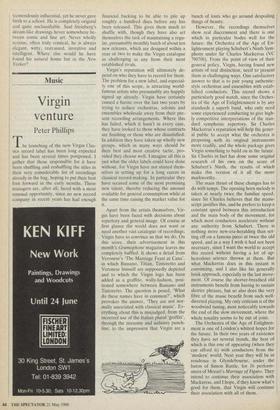Music
Virgin venture
Peter Phillips
The launching of the new Virgin Clas- sics record label has been long expected and has been several times postponed. I gather that those responsible for it have been shuffling and reshuffling the titles in their very considerable list of recordings already in the bag, hoping to put their best foot forward in the early months. These managers are, after all, faced with a most unusual opportunity, since no new record company in recent years has had enough
financial backing to be able to pile up roughly a hundred discs before any has been released. This gives them much to shuffle with, though they have also set themselves the task of maintaining a regu- lar, presumably monthly batch of about ten new releases, which are designed within a year or two to make the Virgin catalogue as challenging as any from their most established rivals.
Virgin's reputation will ultimately de- pend on who they have to record for them. The problem for a new label, and especial- ly one of this scope, is attracting world- famous artists who presumably are happily signed up already. Virgin have certainly caused a furore over the last two years by trying to seduce orchestras, soloists and ensembles wholesale away from their pre- sent recording arrangements. Where this has failed, which it hasn't in every case, they have looked to those whose contracts are finishing or those who are dissatisfied. In addition they have taken up wholly new groups, which in many ways should be their best and most creative tactic, pro- vided they choose well. I imagine all this is just what the older labels could have done without, for Virgin have not stinted them- selves in setting up for a long career in classical record-making. In particular they have secured some of the most promising new talent, thereby reducing the amount available for general consumption while at the same time raising the market value for it.
Apart from the artists themselves, Vir- gin have been faced with decisions about repertory and general image. Of course at first glance the world does not want or need another vast catalogue of recordings; Virgin have to convince us that we do. On this score, their advertisement in this month's Gramophone magazine leaves me completely baffled. It shows a detail from Veronese's 'The Marriage Feast at Cana', in which Bassano, Titian, Tintoretto and Veronese himself are supposedly depicted and to which the Virgin logo has been added as a graffito, wally-fashion, posi- tioned somewhere between Bassano and Tintoretto. The question is posed, 'What do these names have in common?', which provokes the answer, 'They are not nor- mally associated with classical music'. Ev- erything about this is misjudged, from the incorrect use of the Italian plural 'graffiti', through the tiresome and unfunny punch- line, to the impression that Virgin are a
bunch of louts who go around despoiling things of beauty.
However, the recordings themselves show real discernment and there is one which in particular bodes well for the future: the Orchestra of the Age of En- lightenment playing Schubert's Ninth Sym- phony under Sir Charles Mackerras (VC 790708). From the point of view of their general policy, Virgin, having found new artists of real distinction, need to present them in challenging ways. One satisfactory answer to that is to pair young authentic- style orchestras and ensembles with estab- lished conductors. This record shows a particularly good match, since the Orches- tra of the Age of Enlightenment is by any standards a superb band, who only need some experienced conducting to give high- ly competitive interpretations of the stan- dard symphonic repertory. Sir Charles Mackerras's reputation will help the gener- al public to accept what the orchestra is proposing with its original instruments more readily, and the whole package gives Virgin something to build on in the future. Sir Charles in fact has done some original research of his own on the score of Schubert's Ninth, the results of which make this version of it all the more markworthy.
The main thrust of these changes has to do with tempi. The opening horn melody is taken at nearly twice the familiar speed, since Sir Charles believes that the manu- script justifies this, and he prefers to keep a constant speed between this introduction and the main body of the movement, for which most conductors accelerate without any authority from Schubert. There is nothing more new-era-heralding than set- ting off on a famous piece at twice the old speed, and in a way I wish it had not been necessary, since I want the world to accept this record without having a lot of up- heavalous science thrown at them. But what Mackerras does in this instant is convincing, and I also like his generally brisk approach, especially in the last move- ment. Of course the shorter-breathed old instruments benefit from having to sustain shorter phrases, but so also does the very fibre of the music benefit from such well- directed playing. My only criticism is of the woodwind tuning, most noticeably towards the end of the slow movement, where the whole tonality seems to be out of joint.
The Orchestra of the Age of Enlighten- ment is one of London's whitest hopes for the future. In their two years of existence they have set several trends, the best of which is this one of appearing (when they can afford it) with conductors from the 'modern' world. Next year they will be in residence in Glyndebourne, under the baton of Simon Rattle, for 16 perform- ances of Mozart's Marriage of Figaro. They intend to continue their association with Mackerras, and I hope, if they know what's good for them, that Virgin will continue their association with all of them.






























































 Previous page
Previous page